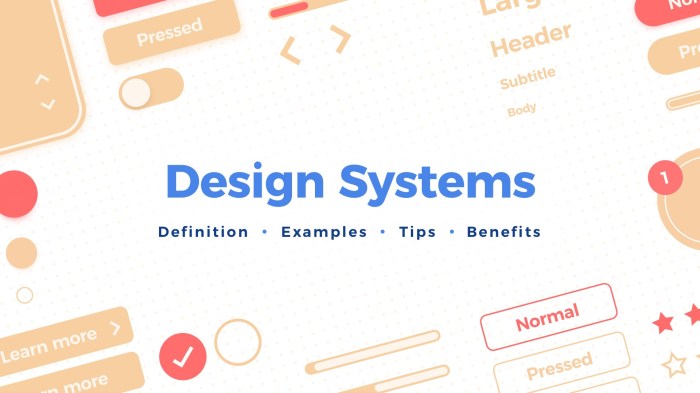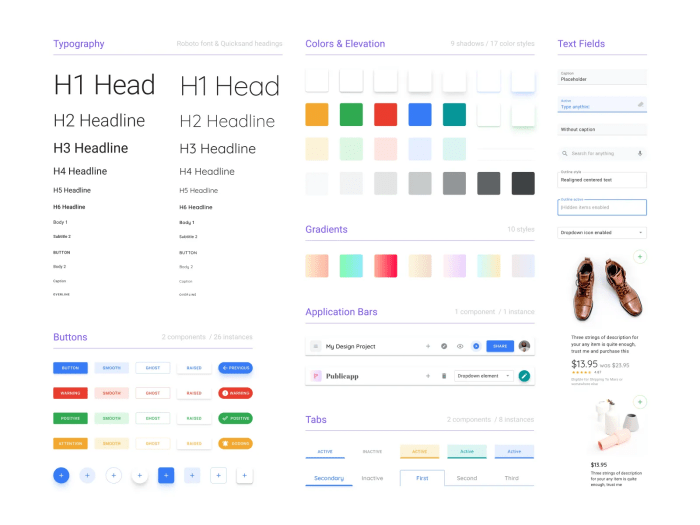Crafting a Comprehensive Design System: A Guide to Consistent User Experiences
With design system at the forefront, this paragraph opens a window to an amazing start and intrigue, inviting readers to embark on a storytelling journey filled with unexpected twists and insights.
Design systems play a crucial role in shaping the digital landscape by ensuring consistent user experiences across various platforms. From defining key components to evolving with changing design trends, a design system is a powerful tool for any development team.
Let's delve deeper into this fascinating world of design systems.
What is a design system?

A design system is a collection of reusable components, guided by clear standards, that can be assembled together to build any number of applications. It includes rules, design principles, and guidelines for creating a consistent user experience across different platforms and devices.
Differentiating a design system from a style guide
A design system goes beyond a style guide by not only defining visual elements like colors, typography, and spacing but also providing a comprehensive set of components, patterns, and behaviors that ensure a cohesive design language throughout a product or organization.
Importance of a design system in creating consistent user experiences
A design system plays a crucial role in maintaining consistency and efficiency in design and development processes. By establishing a shared vocabulary and reusable components, it helps teams work faster, reduce design debt, and deliver a coherent experience to users across various touchpoints.
Components of a design system

Design systems are made up of various key components that work together to ensure consistency and coherence in the design of products and interfaces. These components include:
Color Palette
The color palette is a set of predefined colors that are used consistently throughout a design system. By establishing a color palette, designers can ensure that all elements within a product or interface are visually cohesive and aligned with the brand's identity.
Typography
Typography refers to the selection and implementation of fonts within a design system. Consistent typography helps establish hierarchy, readability, and visual appeal across different screens and devices. It includes considerations such as font sizes, styles, and spacing.
UI Elements
UI elements encompass a wide range of components such as buttons, form fields, icons, and navigation menus. These elements are designed to be reusable and consistent, ensuring a seamless user experience across different parts of a product or interface.
Examples of Components Working Together
For example, a design system may define a specific color from the color palette to be used for primary buttons. This color choice is then applied consistently across all buttons in different parts of the interface. Additionally, the typography guidelines may specify a particular font size and style for headings, which are consistently applied to maintain visual hierarchy.
Role of Design Tokens
Design tokens are variables that store design-related values such as colors, typography settings, and spacing. By using design tokens, designers and developers can easily maintain consistency across components by referencing these variables. For example, a button component can use design tokens for its background color, text color, and border radius, ensuring that any updates to these values are reflected consistently throughout the design system.
Creating a Design System
Creating a design system is a crucial process that involves establishing guidelines and standards for design components to ensure consistency and efficiency in design projects.
Establishing Design Principles
When creating a design system, it is essential to establish clear design principles that will serve as the foundation for all design decisions. These principles should reflect the brand values and goals, guiding designers on how to create a cohesive and user-friendly design system.
Best practices for establishing design principles include:
- Collaborate with key stakeholders to define the core values and objectives of the design system.
- Create a set of design principles that are simple, memorable, and actionable.
- Ensure that design principles are communicated effectively to all team members involved in the design process.
- Regularly review and update design principles to align with evolving business needs and design trends.
Documenting and Maintaining a Design System
Once the design system is established, it is crucial to document and maintain it over time to ensure its effectiveness and scalability. Best practices for documenting and maintaining a design system include:
- Create a centralized repository for all design assets, guidelines, and documentation.
- Regularly update the design system documentation to reflect any changes or additions to design components.
- Provide clear guidelines on how to use design components and ensure that all team members have access to the documentation.
- Implement a version control system to track changes and updates to the design system over time.
Implementing a Design System
Implementing a design system across various platforms can be done using different methods that ensure consistency and efficiency in development. Let's explore the benefits of using design systems for development teams and look at examples of successful implementations.
Methods for Implementation
- Creating a centralized repository for design assets and guidelines accessible to all team members.
- Integrating design tokens for consistent styling across different platforms and devices.
- Utilizing design tools that support design system components and workflows.
- Conducting regular design reviews and updates to ensure the system stays relevant and effective.
Benefits for Development Teams
- Streamlined collaboration and communication among team members working on different projects.
- Efficient design and development processes with reusable components and consistent styles.
- Scalability and flexibility to adapt to changing project requirements and user needs.
- Improved design consistency and brand identity across all digital products and platforms.
Successful Implementations
- IBM's Carbon Design System: A comprehensive design system used across various IBM products and services for a consistent user experience.
- Google's Material Design: An adaptable system that provides guidelines and components for creating cohesive designs across web, mobile, and other platforms.
- Salesforce Lightning Design System: A robust system that enables developers to build accessible and responsive applications with Salesforce's design principles.
Evolving a design system
As design trends are constantly changing, it is essential for a design system to evolve accordingly to stay relevant and effective. Here are some strategies for evolving a design system:
Adapting to Design Trends
- Regularly review and analyze current design trends in the industry.
- Identify areas in the design system that need updates or enhancements based on new trends.
- Collaborate with designers, developers, and stakeholders to implement necessary changes.
Scaling Challenges
Scaling a design system can present challenges as the product grows. Here are some common challenges:
- Maintaining consistency across a growing number of components and patterns.
- Ensuring scalability without compromising performance or usability.
- Managing version control and updates across multiple platforms and devices.
Feedback and User Testing
Feedback loops and user testing play a crucial role in informing updates to a design system. Here's how:
- Collect feedback from designers, developers, and end-users to identify pain points or areas for improvement.
- Conduct user testing to gather insights on how users interact with the design system.
- Iterate on the design system based on feedback and testing results to enhance usability and user experience.
Final Thoughts
In conclusion, a well-crafted design system not only enhances user experiences but also streamlines development processes. By embracing the core principles of consistency and scalability, design systems pave the way for innovation and growth in the digital realm. As you continue your design journey, remember that a strong design system is the foundation for success in today's dynamic design landscape.
Questions Often Asked
What is the difference between a design system and a style guide?
A design system encompasses a broader set of guidelines including design principles, UI components, and more, while a style guide typically focuses on visual elements like colors and typography.
How can design tokens help maintain consistency in a design system?
Design tokens act as reusable variables for design properties like colors and typography, ensuring consistency across all components within the system.
What are the key steps involved in creating a design system?
The key steps include defining design principles, documenting components, establishing guidelines, and ensuring ongoing maintenance.
How can design systems benefit development teams?
Design systems streamline the development process, promote consistency, and enable faster prototyping and iteration for development teams.
What are some strategies for evolving a design system as design trends change?
Strategies include regular updates based on user feedback, staying informed about industry trends, and conducting periodic audits to adapt to changing design needs.




